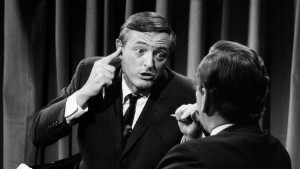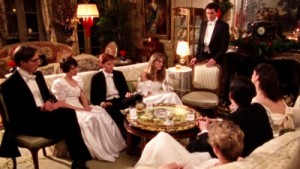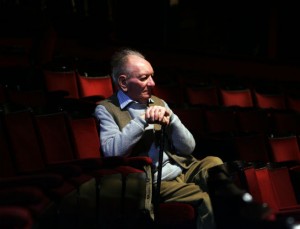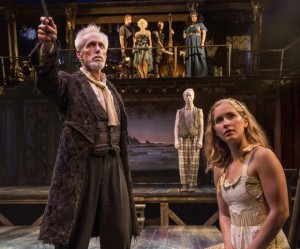 “For one human being to love another: that is perhaps the most difficult of our tasks; the ultimate, the last test and proof, the work for which all other work is but preparation.”
“For one human being to love another: that is perhaps the most difficult of our tasks; the ultimate, the last test and proof, the work for which all other work is but preparation.”
Rainer Maria Rilke, Letters to a Young Poet
Terry Teachout on the arts in New York City
 I have yet to see Best of Enemies, the film documentary on the William F. Buckley, Jr.-Gore Vidal TV debates, originally telecast by ABC in 1968, about which acres of windy prose have lately been published. Nor do I plan to seek it out, since the point of the film is the debates themselves, large chunks of which can be viewed on YouTube. It happens, however, that I was just asked to review a new book about Vidal, so I thought it would make sense to take a look at some of the debates, which I didn’t see at the time (my parents favored CBS).
I have yet to see Best of Enemies, the film documentary on the William F. Buckley, Jr.-Gore Vidal TV debates, originally telecast by ABC in 1968, about which acres of windy prose have lately been published. Nor do I plan to seek it out, since the point of the film is the debates themselves, large chunks of which can be viewed on YouTube. It happens, however, that I was just asked to review a new book about Vidal, so I thought it would make sense to take a look at some of the debates, which I didn’t see at the time (my parents favored CBS).
 Watching the Buckley-Vidal debates now, I’m struck by the fact that both men had ornate, oddly similar mid-Atlantic accents (though Vidal’s, if his earlier TV appearances are any indication, was feigned). Hearing them snipe at one another is like listening to Richard Dimbleby reading the news on the BBC. Can you imagine two men with similar accents jointly appearing on network TV nowadays in any context other than that of a comedy series? It’s hard to conjure up a more telling illustration of how radically American culture has changed in my lifetime, though I find it scarcely less amazing that an hour-long documentary on the Louvre narrated by Charles Boyer had been shown in prime time on the very same network just four years earlier.
Watching the Buckley-Vidal debates now, I’m struck by the fact that both men had ornate, oddly similar mid-Atlantic accents (though Vidal’s, if his earlier TV appearances are any indication, was feigned). Hearing them snipe at one another is like listening to Richard Dimbleby reading the news on the BBC. Can you imagine two men with similar accents jointly appearing on network TV nowadays in any context other than that of a comedy series? It’s hard to conjure up a more telling illustration of how radically American culture has changed in my lifetime, though I find it scarcely less amazing that an hour-long documentary on the Louvre narrated by Charles Boyer had been shown in prime time on the very same network just four years earlier.
On the other hand, we’re as far away in time from The Louvre and the Buckley-Vidal debates as the 1968 nominating conventions were from the presidencies of Woodrow Wilson and Warren G. Harding. To put it another way, we’re as far away in time from The Carol Burnett Show as that program (which I did watch as a boy, devotedly) was from Charlie Chaplin’s The Kid, which was at least as important to American comedy in 1921 as Burnett’s series was in 1968.
Time, it seems, started speeding up in the twentieth century, and it shows no signs of slowing down in the twenty-first—though it goes even faster for those who, like me, are gradually running out of it. I’ve lived long enough to see Bill Buckley and Gore Vidal give way to Bill Maher and John Oliver, just as Carol Burnett has given way to…what? Best Time Ever with Neil Patrick Harris, I suppose, which says all you need to know about the yawning chasm that separates my youth and middle age.
 I never met Vidal and had no wish to do so, but I was acquainted with Bill Buckley. Outside the world of art, he is one of only two people of indisputable historic significance whom I have known at all well. We met not long after I moved to New York in the spring of 1985, and I never quite managed to stop being astonished by the fact that I knew him, not merely because he was important but because he lived in a manner more luxurious than I could easily comprehend. (He is the only person I have ever known who once sent his chauffeured limousine to bring me back to a party.)
I never met Vidal and had no wish to do so, but I was acquainted with Bill Buckley. Outside the world of art, he is one of only two people of indisputable historic significance whom I have known at all well. We met not long after I moved to New York in the spring of 1985, and I never quite managed to stop being astonished by the fact that I knew him, not merely because he was important but because he lived in a manner more luxurious than I could easily comprehend. (He is the only person I have ever known who once sent his chauffeured limousine to bring me back to a party.)
I didn’t realize when we met that Bill’s lifestyle—a word he would surely have hated—was as much a thing of the soon-to-be-past as any of the characters in the novels of Edith Wharton or Louis Auchincloss, but I understood it well before his death in 2008. I marvel that I somehow managed to catch a glimpse of his privileged corner of the world before it, too, vanished.
On the same day that I watched the Buckley-Vidal debates on YouTube, I heard that the New York Daily News had laid off Jim Farber, its pop-music critic, shortly after the New Orleans Times-Picayune announced that it was shutting down its entire music department. Again I felt the moving sidewalk of life accelerating beneath my feet: I covered classical music and dance for the Daily News as a freelancer from 1993 to 2000. It was once my dream to become the chief classical-music critic of a great metropolitan newspaper. Had I attained that goal, I would almost certainly be looking for a job today. Instead I became the drama critic of a great national newspaper, a job that has turned out to suit me better than the one after which I used to hunger. Nevertheless, it’s unsettling to think how close I came to betting on the wrong horse.
 In other, equally unsettling news, Whit Stillman’s Metropolitan has turned twenty-five. Here, too, I have a connection to what has proved to be one of the half-dozen most significant indie films of the Nineties: most of its key scenes were shot after hours in the living room of the same townhouse where I was then holding a salon for like-minded young New York intellectuals (up to a point, Lord Copper!) who were shinnying up the greasy pole of ambition.
In other, equally unsettling news, Whit Stillman’s Metropolitan has turned twenty-five. Here, too, I have a connection to what has proved to be one of the half-dozen most significant indie films of the Nineties: most of its key scenes were shot after hours in the living room of the same townhouse where I was then holding a salon for like-minded young New York intellectuals (up to a point, Lord Copper!) who were shinnying up the greasy pole of ambition.
I recalled that coincidence in a 2001 essay later collected in the Teachout Reader:
Once upon a time, I was running a monthly cocktail party-salon headquartered in a townhouse on the Upper East Side of Manhattan that had once belonged to Alan Jay Lerner. One evening, I showed up to unlock the bar and saw to my amazement that the room in which we gathered each month was full of strange-looking equipment, and the furniture draped with white sheets. Upon further inquiry, I learned that our digs would be temporarily doubling after hours as an interior for a movie, written and directed by a casual acquaintance of mine. People one knew didn’t make movies back in 1989, nor did the acquaintance in question seem even slightly plausible in the role of auteur, but we all made a point of not spilling any booze that night, little knowing that our meeting place would someday come to be revered by independent-movie buffs as the home of the Sally Fowler Rat Pack, the anxiously earnest debs and escorts of Whit Stillman’s Metropolitan.
 “People one knew didn’t make movies back in 1989.” Neither did they write and direct plays—but now I do, a goal that could scarcely have been further from my mind back then, or for long afterward. First I studied music. Then I studied psychology. Then I wrote foreign-policy editorials and ran a salon and wrote a memoir. Then I reviewed concerts and wrote profiles of jazz musicians and a biography of H.L. Mencken. Then I started going to the ballet three times a week and wrote a biography of George Balanchine. Now I sit on the aisles of Broadway and look over the set designs for the latest regional production of Satchmo at the Waldorf and think, Where has the time all gone to?/Haven’t done half the things we want to./Oh, well, we’ll catch up some other time. Except that we never do: we only go forward, pausing on occasion to look back in amazement at the crazy course of the bobsled ride to the grave that is a human life.
“People one knew didn’t make movies back in 1989.” Neither did they write and direct plays—but now I do, a goal that could scarcely have been further from my mind back then, or for long afterward. First I studied music. Then I studied psychology. Then I wrote foreign-policy editorials and ran a salon and wrote a memoir. Then I reviewed concerts and wrote profiles of jazz musicians and a biography of H.L. Mencken. Then I started going to the ballet three times a week and wrote a biography of George Balanchine. Now I sit on the aisles of Broadway and look over the set designs for the latest regional production of Satchmo at the Waldorf and think, Where has the time all gone to?/Haven’t done half the things we want to./Oh, well, we’ll catch up some other time. Except that we never do: we only go forward, pausing on occasion to look back in amazement at the crazy course of the bobsled ride to the grave that is a human life.
* * *
The theatrical trailer for Best of Enemies:
The original 1990 theatrical trailer for Metropolitan:
 “Most men are rather stupid, and most of those who are not stupid are, consequently, rather vain; and it is hardly possible to step aside from the pursuit of truth without falling a victim either to your stupidity or else to your vanity. Stupidity will then attach you to received opinions, and you will stick in the mud; or vanity will set you hunting for novelty, and you will find mare’s-nests.”
“Most men are rather stupid, and most of those who are not stupid are, consequently, rather vain; and it is hardly possible to step aside from the pursuit of truth without falling a victim either to your stupidity or else to your vanity. Stupidity will then attach you to received opinions, and you will stick in the mud; or vanity will set you hunting for novelty, and you will find mare’s-nests.”
A.E. Housman, “The Application of Thought to Textual Criticism” (courtesy of Michael Hendry)
 Brian Friel was barely more than a name to me when I became the drama critic of The Wall Street Journal in 2003. No play of his had been done on Broadway since Translations ran briefly there eight years earlier. Hence it came as a shock when I saw the Irish Repertory Theatre’s 2005 revival of Philadelphia, Here I Come! and realized at once that it was a work of the highest quality—a masterpiece, in fact. I resolved on the spot to see as many of his plays as I possibly could, and before long it was apparent to me that he and Tom Stoppard were the foremost living playwrights of the English-speaking world.
Brian Friel was barely more than a name to me when I became the drama critic of The Wall Street Journal in 2003. No play of his had been done on Broadway since Translations ran briefly there eight years earlier. Hence it came as a shock when I saw the Irish Repertory Theatre’s 2005 revival of Philadelphia, Here I Come! and realized at once that it was a work of the highest quality—a masterpiece, in fact. I resolved on the spot to see as many of his plays as I possibly could, and before long it was apparent to me that he and Tom Stoppard were the foremost living playwrights of the English-speaking world.
In due course I became, willy-nilly, something of an advocate for Friel. Not that he needed one—he is universally recognized in Ireland and England as a great writer—but his work has never been widely popular in the United States, and I have since done what I could to make it better known over here, covering twelve Friel revivals in The Wall Street Journal since 2003. As a result, I’ve already said in print most of what I would normally say in an obituary.
This passage from “Chekhov’s Fingerprints,” my 2009 review of the Florida Repertory Theatre production of Dancing at Lughnasa, sums up my feelings as well as anything:
Brian Friel, the greatest playwright of our time, is an Irishman whose works have the fingerprints of a Russian all over them. Anton Chekhov, Mr. Friel’s master, wrote plays in which plot takes a back seat to atmosphere, and Russia itself is always the star of the show. As Mr. Friel has pointed out, Chekhov’s flesh-and-blood characters “behave as if their old certainties were as sustaining as ever—even though they know in their hearts that their society is in meltdown and the future has neither a welcome nor even an accommodation for them. Maybe a bit like people of my own generation in Ireland today.” Might it be this transnational spirit that also makes Mr. Friel’s plays so accessible to American audiences and actors?…
A cross between Three Sisters and The Glass Menagerie, Dancing at Lughnasa is a semiautobiographical memory play whose narrator tells what happened to his family during two summer days in 1936. Young Michael lives in a cottage with Chris, his unmarried mother, and her four sisters, all of whom are barely making ends meet. The longings and frustrations of the Mundy sisters have grown too great to bear, and what was once a close-knit family is now—like Europe itself—on the verge of disintegration. The genius of Dancing at Lughnasa is that Mr. Friel has portrayed this sunset hour with the lightest of comic touches, letting the audience laugh as the black shadows that surround the Mundys grow imperceptibly longer.
Alas, there hasn’t been a New York production of any of Friel’s plays since 2012, when the Irish Rep staged The Freedom of the City, and none of them has been produced on Broadway since Translations was revived there in 2007. Perhaps his death at the age of eighty-six will lead to wider American interest in his work.
A personal note: it was Friel and Horton Foote, his opposite number on this side of the Atlantic, who initially inspired me when I first began to write for the stage. I shall always be grateful without stint to both men—neither of whom I ever had the privilege to meet—for what their example has meant to me.
The stage of the world feels empty this morning.
* * *
Excerpts from the 2006 Broadway revival of Faith Healer, starring Ralph Fiennes:
The opening of John Ousted’s 1974 film version of Philadelphia, Here I Come!, starring Donal McCann and Des Cave:
The trailer for Pat O’Connor’s 1998 film version of Dancing at Lughnasa, starring Meryl Streep:
In today’s Wall Street Journal I review the Broadway transfer of Deaf West Theatre’s revival of Spring Awakening and the Chicago transfer of the Aaron Posner-Teller production of The Tempest. Here’s an excerpt.
* * *
It’s been twelve years since Hollywood’s Deaf West Theatre brought its sublime staging of “Big River,” the 1985 musical based on “Adventures of Huckleberry Finn,” to Broadway. I couldn’t imagine going in how a mixed cast of deaf and hearing actors would manage to make theatrical sense out of a musical, but I was cheering my head off by evening’s end. So I’m not at all surprised that the Broadway transfer of Deaf West’s revival of “Spring Awakening,” directed by Michael Arden, makes an impression that is, if anything, even more overwhelming than “Big River.”
 I say this even though I’m not a fan of the Steven Sater-Duncan Sheik rock-and-roll version of Frank Wedekind’s 1891 play about pubescent sexuality, which I found cloyingly sentimental when it opened in 2006. Few things in theater are rarer than a production so fine that it cries out to be seen in spite of the show, but that’s the case with Deaf West’s “Spring Awakening”: It ranks among the most emotionally charged renderings of a musical to come to Broadway in the past decade, one that all who love the genre should rush to see….
I say this even though I’m not a fan of the Steven Sater-Duncan Sheik rock-and-roll version of Frank Wedekind’s 1891 play about pubescent sexuality, which I found cloyingly sentimental when it opened in 2006. Few things in theater are rarer than a production so fine that it cries out to be seen in spite of the show, but that’s the case with Deaf West’s “Spring Awakening”: It ranks among the most emotionally charged renderings of a musical to come to Broadway in the past decade, one that all who love the genre should rush to see….
Mr. Arden’s work is new to me, but I think it’s safe to say that he’s going to be big, not least because he has triumphantly solved the problem—so well that it no longer seems problematic—of fusing deaf and hearing actors into an indissoluble whole. Every word of “Spring Awakening” is also “spoken” in American Sign Language, sometimes individually and sometimes in chorus, and Mr. Arden has found a seemingly endless number of ways to use this convention to stunningly beautiful, almost ballet-like effect….
 Chicago Shakespeare Theater has remounted the magic-show staging of “The Tempest” by Aaron Posner and Teller (better known as the quieter half of Penn & Teller) that I saw last year in Cambridge, Mass., and praised as “fanciful, mysterious and full of cheerily broad comedy….It is—in a word—magical.”
Chicago Shakespeare Theater has remounted the magic-show staging of “The Tempest” by Aaron Posner and Teller (better known as the quieter half of Penn & Teller) that I saw last year in Cambridge, Mass., and praised as “fanciful, mysterious and full of cheerily broad comedy….It is—in a word—magical.”
Why review it a second time? Because American Repertory Theatre’s original production featured a troupe of youthful actors who weren’t quite able to make magic out of Shakespeare’s verse. Not so this much more strongly cast version, in which Prospero, Shakespeare’s vengeful sorcerer, is played by Larry Yando, the Chicago-based performer whose appearances in Writers Theatre’s “Dance of Death” and Chicago Shakespeare’s “King Lear” established him as one of this country’s foremost classical actors. Once again Mr. Yando outdoes himself, giving a performance in which the sardonic rasp of rage gives way to the quiet voice of reconciliation….
* * *
To read my review of Spring Awakening, go here.
To read my review of The Tempest, go here.
The trailer for Spring Awakening:
The trailer for The Tempest:
| M | T | W | T | F | S | S |
|---|---|---|---|---|---|---|
| 1 | 2 | 3 | 4 | |||
| 5 | 6 | 7 | 8 | 9 | 10 | 11 |
| 12 | 13 | 14 | 15 | 16 | 17 | 18 |
| 19 | 20 | 21 | 22 | 23 | 24 | 25 |
| 26 | 27 | 28 | 29 | 30 | 31 | |
An ArtsJournal Blog